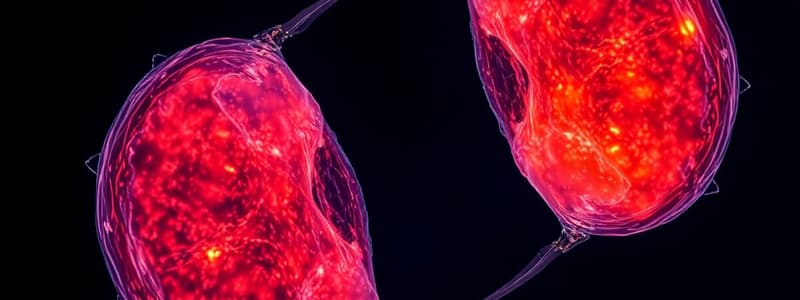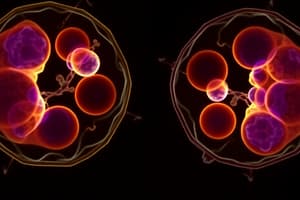Podcast
Questions and Answers
What happens during the G2 stage of interphase?
What happens during the G2 stage of interphase?
- DNA replication occurs.
- Proteins needed for cell division are synthesized. (correct)
- The cell undergoes apoptosis.
- The cell doubles its organelles.
Which stage of the cell cycle is primarily focused on DNA replication?
Which stage of the cell cycle is primarily focused on DNA replication?
- S Stage (correct)
- G2 Stage
- G1 Stage
- M Stage
What is the role of the G1 checkpoint in the cell cycle?
What is the role of the G1 checkpoint in the cell cycle?
- To trigger apoptosis when necessary.
- To ensure adequate nutrients and cell size before DNA synthesis. (correct)
- To coordinate DNA replication.
- To assess the readiness for mitosis.
What distinguishes mitosis from meiosis?
What distinguishes mitosis from meiosis?
What occurs during cytokinesis?
What occurs during cytokinesis?
What is the consequence of failing the cell cycle control mechanisms?
What is the consequence of failing the cell cycle control mechanisms?
During which phase of interphase does the cell prepare for DNA synthesis by accumulating necessary materials?
During which phase of interphase does the cell prepare for DNA synthesis by accumulating necessary materials?
What defines apoptosis in the context of the cell cycle?
What defines apoptosis in the context of the cell cycle?
What is the primary purpose of cytokinesis during cell division?
What is the primary purpose of cytokinesis during cell division?
What is the outcome of meiosis I?
What is the outcome of meiosis I?
During which stage of meiosis does crossing over occur?
During which stage of meiosis does crossing over occur?
Which statement accurately describes anaphase I?
Which statement accurately describes anaphase I?
What characterizes meiosis II when compared to mitosis?
What characterizes meiosis II when compared to mitosis?
In which stage do chromosomes become arranged along the metaphase plate during meiosis II?
In which stage do chromosomes become arranged along the metaphase plate during meiosis II?
How many chromosomes will each daughter cell contain after completing telophase II of meiosis?
How many chromosomes will each daughter cell contain after completing telophase II of meiosis?
What happens to the nuclear membrane during prophase II?
What happens to the nuclear membrane during prophase II?
What are sister chromatids?
What are sister chromatids?
What occurs during prophase of mitosis?
What occurs during prophase of mitosis?
What is the role of centrosomes during cell division?
What is the role of centrosomes during cell division?
How many chromosomes do humans have?
How many chromosomes do humans have?
During which phase do sister chromatids separate?
During which phase do sister chromatids separate?
What is the metaphase plate?
What is the metaphase plate?
Which statement is true about sex chromosomes in humans?
Which statement is true about sex chromosomes in humans?
What happens to spindle fibers during telophase?
What happens to spindle fibers during telophase?
Flashcards are hidden until you start studying
Study Notes
Cell Cycle Overview
- The cell cycle consists of events for cell growth and division: Interphase and Cell Division.
- Interphase: the stage where the cell prepares for division, growing larger and replicating DNA and organelles.
Interphase Stages
- G1 Phase:
- Cells double organelles and gather materials for DNA synthesis.
- S Phase:
- DNA replication occurs, resulting in chromosomes composed of two identical sister chromatids.
- G2 Phase:
- Proteins necessary for cell division are synthesized.
Cell Division
- Includes Mitosis and Cytokinesis.
- Mitosis:
- Nuclear division where one copy of DNA is distributed to daughter cells.
- Cytokinesis:
- Cytoplasmic division resulting in two new cells, each with organelles.
Checkpoints in Cell Cycle
- Controlled by checkpoints:
- G1 checkpoint, G2 checkpoint, and the M phase checkpoint.
- Failure in checkpoints may lead to uncontrolled growth and cancer.
Chromosomes Basics
- Genetic material resides in the nucleus, packaged as chromosomes (DNA + proteins = chromatin).
- In non-dividing cells, chromatin appears as a tangled mass; during division, it condenses into visible chromosomes made of sister chromatids.
Human Chromosome Count
- Humans have 46 chromosomes (23 pairs).
- Autosomes: 22 pairs shared by all and one pair of sex chromosomes determining gender (XX in females, XY in males).
Mitosis Phases
- Prophase:
- Centrosomes duplicate, spindle fibers form, nuclear envelope fragments, and visible chromosomes condense.
- Prometaphase:
- Spindle fibers attach to centromeres; chromosomes further condense.
- Metaphase:
- Chromosomes align at the metaphase plate attached to spindle fibers.
- Anaphase:
- Sister chromatids separate and are pulled to opposite poles, now considered individual chromosomes.
- Telophase:
- Chromosomes reach poles, re-condense to chromatin, and the nuclear envelope and nucleolus reappear.
Cytokinesis Mechanism
- Actin filaments form a contractile ring, pinching the cell membrane inwards to create two daughter cells.
- Each daughter cell is diploid (2n) with 46 chromosomes, genetically identical to the parent cell.
Meiosis Overview
- Meiosis: reduction division with two successive cell divisions (Meiosis I and II) without interphase.
- The parent cell is diploid (2n) with homologous chromosomes.
Meiosis I Phases
- Prophase I:
- Homologous chromosomes form tetrads and may undergo crossing over, leading to genetic variation.
- Metaphase I:
- Homologous chromosome pairs align at the metaphase plate.
- Anaphase I:
- Homologous chromosomes are pulled toward opposite poles, each still consisting of two chromatids.
- Telophase I:
- Each pole receives a haploid set of chromosomes, nuclear membranes form around each set.
Meiosis II Phases
- Similar to mitosis, involves the division of the two haploid cells produced in Meiosis I.
- Prophase II:
- Centrioles move to poles, spindle fibers form, and chromosomes condense.
- Metaphase II:
- Chromosomes align along the metaphase plate.
- Anaphase II:
- Centromeres divide, and sister chromatids move to opposite poles.
- Telophase II:
- Chromosomes elongate, nuclear membranes form, resulting in four haploid daughter cells (n) with half the original chromosome number.
Studying That Suits You
Use AI to generate personalized quizzes and flashcards to suit your learning preferences.




